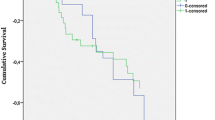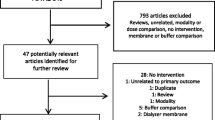Abstract
Objective
To investigate the influence of continuous haemofiltration (CHF) on haemodynamics, gas exchange and core temperature in critically ill septic patients with acute renal failure.
Patients and methods
In 20 patients (17 male, 3 female) ultrafiltration rate, core temperature, gas exchange and haemodynamic variables were measured at regular intervals during the first 48 h of haemofiltration. Baseline data were compared to those obtained 30 min after initiating CHF and also to those during hypothermia (if observed).
Main results
Haemodynamic variables remained remarkably constant throughout the study period. In patients with a relatively low ultrafiltration rate (855±278 ml/h) temperature did not change, while in patients with a high ultrafiltration rate (1468±293 ml/h) core temperature significantly decreased from 37.6±0.9°C to 34.8±0.8°C (p<0.001). There was a statistically significant correlation between temperature decrease and ultrafiltration rate (r=−0.68, Y=1.8−0.003 X,p<0.01). Hypothermic patients also showed a mean decrease in VO2 from 141±22 ml/min/m2 to 112±22 ml/min/m2 (p<0.01) with a concomitant increase in PaO2 from 103±37 mmHg to 140±42 mmHg (p<0.001) and in P\(\bar v\)O2 from 35±4 mmHg to 41±5 mmHg (p<0.001).Conclusions: 1) Continuous haemofiltration does not cause significant alternations in haemodynamic variables. 2) Hypothermia frequently occurs in patients undergoing continuous haemofiltration with high ultrafiltration rates. These hypothermic patients show a reduction in\(\dot V\)O2 leading to an increase in P\(\bar v\)O2 and PaO2. This mild hypothermia in these circumstances has no evident deleterious effects.
Similar content being viewed by others
References
Schetz M, Lauwers PM, Ferdinande P (1989) Extracorporeal treatment of acute renal failure in the intensive care unit: a critical view. Intensive Care Med 15:349–357
Wendon J, Smithies M, Sheppard M, Bullen K, Tinker J, Bihari D (1989) Continuous high volume venous-venous haemofiltration in acute renal failure. Intensive Care Med 15:358–363
Buchardi H (1989) Haemofiltration. In: Vincent JL (ed) Update in intensive care and emergency medicine. Springer, Berlin Heidelberg New York Tokyo, pp 340
Voerman HJ, Strack van Schijndel RJM, Thijs LG (1990) Continuous arterial-venous haemodifiltration in critically ill patients. Crit Care Med 18:911–914
Stein B, Pfenninger E, Grunert A, Schmitz JE, Hudde M (1990) Influence of continuous haemofiltration on haemodynamics and central blood volume in experimental shock. Intensive Care Med 16:494–499
Ossenkoppele GJ, Vander Meulen J, Bronsveld W, Thijs LG (1985) Continuous arteriovenous haemofiltration as an adjunctive therapy for septic shock. Crit Care Med 13:102–104
Gotloib L, Barzilay E, Shustak A, Wais Z, Jaichenko J, Lev A (1986) Hemofiltration in septic ARDS. The artificial kidney as an artificial endocrine lung. Resuscitation 13:123–132
Barzilay E, Kessler D, Berlot G, Gullo A, Geber D, Ben Zeev I (1989) Use of extracorporeal supportive techniques as additional treatment for septic induced multiple organ failure patients. Crit Care Med 17:634–637
Rouby JJ, Rottembourg M, Durante JP, Basset JY, Degoulet P, Glaser P, Legrain M (1980) Haemodynamic changes induced by regular haemodialysis and sequential ultrafiltration haemodialysis: a comparative study. Kidney Int 17:801–810
Heyka RJ, Paganini EP (1989) Blood pressure control in chronic dialysis patients. In: Mahler JF (ed) Replacement of renal function by dialysis. Kluwer, pp 782
De Broe ME, Lins RR, De Backer WA (1989) Pulmonary aspects of dialysis patients. In: Maher JF (ed) Replacement of renal function by dialysis. Kluwer, pp 828
Eschbach JW (1989) Haematological problems of dialysis patients. In: Maher JF (ed) Replacement of renal function by dialysis. Kluwer, pp 859
Bone R (1991) Sepsis, the sepsis syndrome, multi-organ failure: a plea for comparable definitions. Ann Intern Med 114:332–333
Fromm RE, Guimont JJ, Darby J, Snider J (1987) The craft of cardiopulmonary profile analysis: In: Snider J, Pinsky M (ed) Oxygen transport in the critically ill. Year Book Medical Publishers, pp 249–269
Bouffard Y, Viale JP, Annat G, Guillaume C, Percival C, Bertrand O, Motin J (1986) Pulmonary gas exchange during haemodialysis. Kidney Int 30:920–923
Bursztein S, Elwyn DH, Askanazi et al (1989) The theoretical framework of indirect calorimetry and energy balance. In: Energy metabolism, indirect calorimetry and nutrition. Williams and Wilkins, Baltimore, pp 27–83
Du Bois EF (1954) Energy metabolism. Ann Rev Physiol 16:125–134
West JB (1977) Ventilation-perfusion relationships. Am Rev Respir Dis 116:919–943
Dantzker DR (1990) The influence of mixed venous PO2 on arterial oxygenation. In: Vincent JL (ed) Update in intensive care and emergency medicine. Springer, Berlin Heidelberg New York Tokyo, pp 131–137
Harari A, Regnier B, Rapin M, Lemaire F, Le Gall JR (1975) Haemodynamic study of prolonged deep accidental hypothermia. Intensive Care Med 1:65–70
Thauer R (1965) The circulation in hypothermia of nonhibernating animals and men. In: Hamilton WF, Dow P (eds) Handbook of physiology. Circulation, vol III. American Physiological Society, Washington, pp 1899–1920
Hansen JE, Sue DY (1980) Should blood gas measurements be corrected for the patient's temperature? N Engl J Med 303:341
Author information
Authors and Affiliations
Rights and permissions
About this article
Cite this article
Matamis, D., Tsagourias, M., Koletsos, K. et al. Influence of continuous haemofiltration-related hypothermia on haemodynamic variables and gas exchange in septic patients. Intensive Care Med 20, 431–436 (1994). https://doi.org/10.1007/BF01710654
Received:
Accepted:
Issue Date:
DOI: https://doi.org/10.1007/BF01710654




